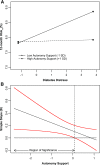Diabetes Distress and Glycemic Control: The Buffering Effect of Autonomy Support From Important Family Members and Friends
- PMID: 29599295
- PMCID: PMC5961390
- DOI: 10.2337/dc17-2396
Diabetes Distress and Glycemic Control: The Buffering Effect of Autonomy Support From Important Family Members and Friends
Abstract
Objective: To examine whether autonomy support (defined as social support for an individual's personal agency) for diabetes management from informal health supporters (family/friends) reduces the detrimental effects of diabetes distress on glycemic control.
Research design and methods: Three hundred eight veterans with type 2 diabetes and one or more risk factors for diabetes complications completed a survey that included measures of diabetes distress and perceived autonomy support from their main informal health supporter. Hemoglobin A1c (HbA1c) data from 12 months before and after the survey were extracted from electronic medical records. Linear mixed modeling examined the main effects and interaction of autonomy support and diabetes distress on repeated measures of HbA1c over the 12 months after the survey, controlling for mean prior 12-month HbA1c, time, insulin use, age, and race/ethnicity.
Results: Diabetes distress (B = 0.12 [SE 0.05]; P = 0.023) was associated with higher and autonomy support (B = -0.16 [SE 0.07]; P = 0.032) with lower subsequent HbA1c levels. Autonomy support moderated the relationship between diabetes distress and HbA1c (B = -0.13 [SE 0.06]; P = 0.027). Greater diabetes distress was associated with higher HbA1c at low (B = 0.21 [SE 07]; P = 0.002) but not high (B = 0.01 [SE 0.07]; P = 0.890) levels of autonomy support.
Conclusions: Autonomy support from main health supporters may contribute to better glycemic control by ameliorating the effects of diabetes distress. Interventions that reduce diabetes distress and enhance the autonomy supportiveness of informal supporters may be effective approaches to improving glycemic control.
© 2018 by the American Diabetes Association.
Figures

Similar articles
-
Diabetes self-management and glycemic control: The role of autonomy support from informal health supporters.Health Psychol. 2019 Feb;38(2):122-132. doi: 10.1037/hea0000710. Health Psychol. 2019. PMID: 30652911 Free PMC article.
-
Autonomy support from informal health supporters: links with self-care activities, healthcare engagement, metabolic outcomes, and cardiac risk among Veterans with type 2 diabetes.J Behav Med. 2021 Apr;44(2):241-252. doi: 10.1007/s10865-020-00196-5. Epub 2020 Nov 27. J Behav Med. 2021. PMID: 33247416 Free PMC article.
-
Psychological distress, self-efficacy and glycemic control in type 2 diabetes.Nutr Metab Cardiovasc Dis. 2017 Apr;27(4):300-306. doi: 10.1016/j.numecd.2017.01.006. Epub 2017 Jan 31. Nutr Metab Cardiovasc Dis. 2017. PMID: 28274728
-
The role of depression and diabetes distress in glycemic control: A meta-analysis.Diabetes Res Clin Pract. 2025 Mar;221:112014. doi: 10.1016/j.diabres.2025.112014. Epub 2025 Jan 30. Diabetes Res Clin Pract. 2025. PMID: 39892818 Review.
-
Diabetes distress: understanding the hidden struggles of living with diabetes and exploring intervention strategies.Postgrad Med J. 2015 May;91(1075):278-83. doi: 10.1136/postgradmedj-2014-133017. Epub 2015 Mar 31. Postgrad Med J. 2015. PMID: 25827438 Review.
Cited by
-
Older Chinese and Filipino American Immigrants with Type 2 Diabetes and their Adult Child: A Qualitative Dyadic Exploration of Family Support.J Cross Cult Gerontol. 2024 Jun;39(2):151-172. doi: 10.1007/s10823-024-09505-w. Epub 2024 May 9. J Cross Cult Gerontol. 2024. PMID: 38720112 Free PMC article.
-
The moderating role of diabetes distress on the effect of a randomized eHealth intervention on glycemic control in Black adolescents with type 1 diabetes.J Pediatr Psychol. 2024 Aug 1;49(8):538-546. doi: 10.1093/jpepsy/jsae033. J Pediatr Psychol. 2024. PMID: 38775162 Free PMC article. Clinical Trial.
-
Rationale, design, and recruitment outcomes for the Family/Friend Activation to Motivate Self-care (FAMS) 2.0 randomized controlled trial among adults with type 2 diabetes and their support persons.Contemp Clin Trials. 2022 Nov;122:106956. doi: 10.1016/j.cct.2022.106956. Epub 2022 Oct 5. Contemp Clin Trials. 2022. PMID: 36208719 Free PMC article. Clinical Trial.
-
Development of a Typology of Diabetes-Specific Family Functioning Among Adults With Type 2.Ann Behav Med. 2021 Oct 4;55(10):956-969. doi: 10.1093/abm/kaab009. Ann Behav Med. 2021. PMID: 33761527 Free PMC article.
-
Social support and diabetes distress among adults with type 2 diabetes covered by Alabama Medicaid.Diabet Med. 2021 Apr;38(4):e14503. doi: 10.1111/dme.14503. Epub 2021 Jan 7. Diabet Med. 2021. PMID: 33351189 Free PMC article.
References
-
- Powers MA, Bardsley J, Cypress M, et al. . Diabetes self-management education and support in type 2 diabetes: a joint position statement of the American Diabetes Association, the American Association of Diabetes Educators, and the Academy of Nutrition and Dietetics. Diabetes Educ 2015;41:417–430 - PubMed
-
- Funnell MM, Tang TS, Anderson RM. From DSME to DSMS: developing empowerment-based diabetes self-management support. Diabetes Spectr 2007;20:221–226
Publication types
MeSH terms
Substances
Grants and funding
LinkOut - more resources
Full Text Sources
Other Literature Sources
Medical
Miscellaneous

